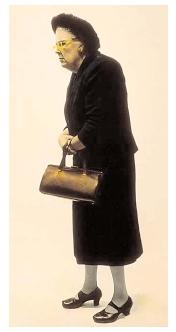 We're talking today about what one of my clients refers to as "The Dowager Hump" (which her dad has, and which I think sounds dirty): Kyphosis.
We're talking today about what one of my clients refers to as "The Dowager Hump" (which her dad has, and which I think sounds dirty): Kyphosis.Kyphosis is the opposite of lordosis, and basically means that your spine loses part of it's natural curve. That means that there are a couple different kinds of kyphosis, but the one that I want to talk about is basic postural kyphosis, or the dowager hump variety. Normally, dowager humping (mind out of the gutters, guys) is relegated to the very young and the very old. I have one lady in one of my water aerobics classes who is so severely kyphotic (as a result of osteoporosis and several compression fractures) that she looks as if God put his hand on her head and squished her down.
But in spite of their almost uniform lack of extreme old age/youth (I know there are a few exceptions), I believe that triathletes are uniquely susceptible to this postural deformity because of two things: extended cycling followed by fatigued running. A little bit of rounding in the back (shallow thoracic kyphosis, to be precise) is normal. But--and this goes hand-in-hand with winged scapula--I have seem some pretty severe cases while watching triathletes at races, particularly longer races like Kansas 70.3.
So you're kyphotic. What do you do about it? So glad you asked!
Stop slouching!
This is the most obvious one. If you practice better posture, you will have better posture. So straighten up! Do it right now! I know you're probably slouched over your keyboard and mouse as you're reading this (I am as I'm writing it). Tighten your lats, rhomboids, and lower trapezius muscles, square your shoulders, and regain the natural curve of your back. When cycling, roll your shoulders back and down. Actually, when doing anything roll your shoulders back and down. When running, shake out your arms to loosen them up. Then roll them back and down. Believe me, once you become aware of how often you slouch when working out, you'll be doing this every five minutes.
Uddiyana Bandha
This is a Sanskrit term used in Yoga. It means "flying up muscle lock." It has helped me immensely with my posture in swimming, cycling, and running (as well as in Yoga, natch). Stand tall with chest lifted and shoulders down. When you're standing properly, you should feel like you're holding your thorax up off of your abs and vital organs. Lungs should feel expanded. Now suck your stomach in and up--that is, pull the innermost abdominals (the transverse abdominus) in and up towards the heart. That's why it uses the term "flying up" (Uddiya); it's like your muscles are flying up into your body. When you're swimming, biking, and running, try to hold onto that feeling. It'll engage the transverse abdominus, and the multifidus (tiny little muscles along your spine) will fire along with it to support your spine from the inside out. And if you have stamina with this muscle lock, it'll enable you to keep your chest lifted up and off your stomach even when fatigued, which will make it easier to get breath in.
Shoulder pinch
Stand with your arms held directly in front of your shoulders. Squeeze the shoulder blades together without abducting the arms or raising the shoulders. Try to feel the muscles working. Those are your rhomboids, and chances are good that they could stand to be stronger.
Any kind of row
Seated cable row. One arm dumbbell row. Standing row with rotation. Use weights. Use tubing. Use a cable. Whichever you do, focus on keeping your shoulders down and back, your chest lifted, and keep squeezing your shoulder blades together. Pretend that your arch-nemesis stuck their finger in the middle of your back and you're trying to hold them there so you can kick them where the sun don't shine. Or, as my training mentor says, pretend you're crushing a pop can between your shoulder blades. Either one. It's up to you.
Why bother with all this? Why correct a postural deformity that is becoming so common you look weird if you're not doing it?
In my mind, it's a matter of performance. When you let your upper body collapse down into itself, you're reducing your body's ability to effectively take in air. That means less oxygen in the lungs, less oxygen in the blood, less oxygen to the working muscles when it's late in a race and you're tired. Good posture--what Marc Evans refers to as "athletic posture"--is key to athletic performance. That's why the first chapter of his book, Triathlete's Edge, is all about analyzing and diagnosing possible postural deficiencies. He begins there because he recognizes it as an important first step to improved running, biking, and swimming performance.
Besides which, you definitely do not want "Dowager Humper" to be your tri nickname.

all this brought back manymany memories from my personal training certification :)
ReplyDeleteid forgotten more than Id thought!
who knew?
Good article, though kyphosis isn't exactly the opposite of lordosis. Rather, they tend to go hand in hand, as one occurs to rebalance the weight shifted by the other. For example, I have a lordotic lumbar spine and a kyphotic thoracic spine.
ReplyDelete